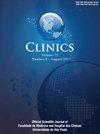Effect of combined training on the cardiorespiratory, muscle system and body composition in employees at a tertiary hospital after mild to moderate intensity COVID 19
IF 2.4
4区 医学
Q2 MEDICINE, GENERAL & INTERNAL
引用次数: 0
Abstract
Objective
To verify the effect of 12 weeks of Combined Training (CT) in patients suffering from COVID-19 of mild to moderate intensity.
Methods
69 participants diagnosed with mild to moderate COVID-19 were evaluated, with shortness of breath as the main symptom. All of them were sent by the Centro de Atendimento ao Funcionário do Hospital das Clínicas da Faculdade de Medicina da Universidade de São Paulo (CEAC-HCFMUSP). The sample was divided into three groups: Group 1 (G1) – 26 patients diagnosed with COVID-19 evaluated before and after combined training together with nutritional guidance. Group 2 (G2) – 21 patients diagnosed with COVID-19 were evaluated before and after 12 weeks. Patients in G2 (control) did not participate in the protocol but were instructed to train outside the hospital and did not receive nutritional guidance. Group 3 (G3) – 22 patients diagnosed with COVID-19 were evaluated before and after combined training along with nutritional monitoring and post-workout whey protein supplementation throughout the duration of the protocol.
Results
The three groups did not have significant statistical differences when compared to each other, but there was significant intragroup improvement in the analyzed variables. There was an improvement in cardiorespiratory, metabolic, and muscular fitness. Furthermore, late symptoms of the disease were reduced at the end of the program.
Conclusion
The results of the dependent variables analyzed were significant within groups, CT was an efficient training model in improving the patient's general condition (fatigue and dyspnea) when training was controlled with supervision.
轻、中强度新型冠状病毒肺炎后三级医院员工心肺、肌肉系统和身体成分的联合训练
目的验证12周联合训练(CT)对中轻强度新冠肺炎患者的治疗效果。方法以呼吸短促为主要症状,对69例轻中度COVID-19患者进行评估。所有病例均由圣保罗圣保罗大学医学院(CEAC-HCFMUSP) Funcionário医院医疗中心(Clínicas)派遣。样本分为三组:第一组(G1) - 26例诊断为COVID-19的患者,在联合训练和营养指导的前后进行评估。第2组(G2) - 21例诊断为COVID-19的患者在12周前后进行评估。G2组(对照组)患者不参与方案,但被指示在医院外进行培训,不接受营养指导。第3组(G3) - 22名诊断为COVID-19的患者在联合训练前后进行评估,并在整个方案期间进行营养监测和运动后补充乳清蛋白。结果三组间比较差异无统计学意义,但组内各分析变量均有显著改善。心肺、代谢和肌肉健康均有改善。此外,在项目结束时,疾病的晚期症状有所减轻。结论组内因变量分析结果具有显著性,在训练控制和监督下,CT是一种有效的改善患者一般情况(疲劳和呼吸困难)的训练模式。
本文章由计算机程序翻译,如有差异,请以英文原文为准。
求助全文
约1分钟内获得全文
求助全文
来源期刊

Clinics
医学-医学:内科
CiteScore
4.10
自引率
3.70%
发文量
129
审稿时长
52 days
期刊介绍:
CLINICS is an electronic journal that publishes peer-reviewed articles in continuous flow, of interest to clinicians and researchers in the medical sciences. CLINICS complies with the policies of funding agencies which request or require deposition of the published articles that they fund into publicly available databases. CLINICS supports the position of the International Committee of Medical Journal Editors (ICMJE) on trial registration.
 求助内容:
求助内容: 应助结果提醒方式:
应助结果提醒方式:


